
The Grand Court by William Henry Jackson, for the Detroit Publishing Co., Trans-Mississippi Exposition, Omaha, Neb., c. 1898. Photochromatic print, courtesy Library of Congress
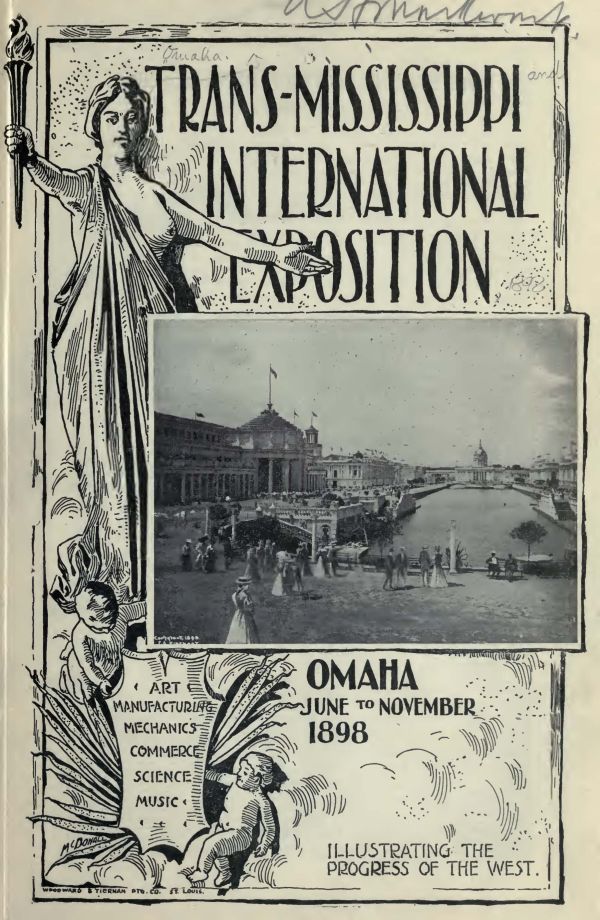
Promotional material for Omaha's 1898 Trans-Mississippi International Exposition, courtesy City of Omaha Heritage Preservation
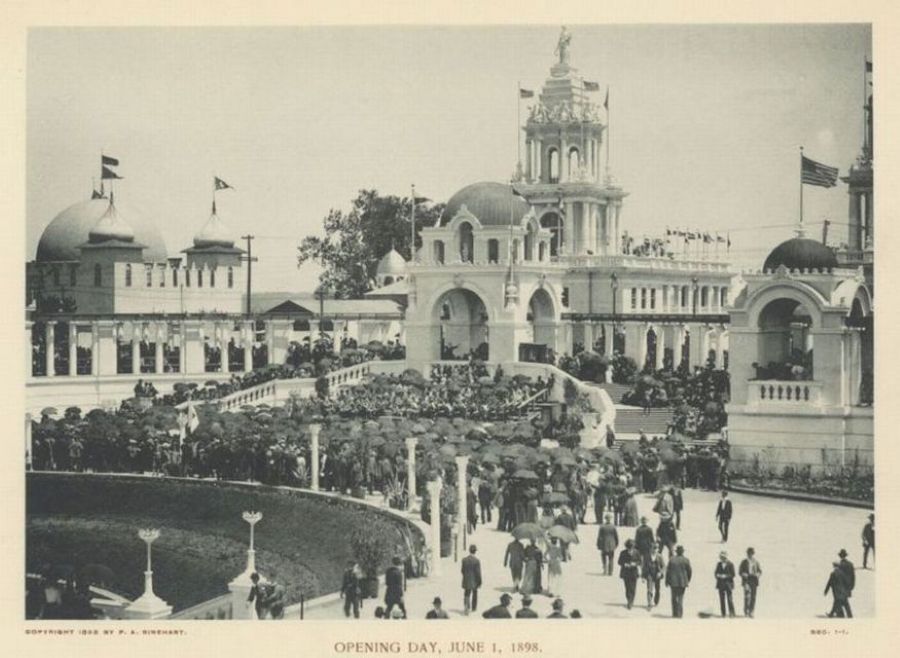
Opening Day, June 1, 1898 Trans-Mississippi International Exposition, Photograph by Rinehart ("Rinehart's Book of Views 1898") Center for Digital Research in the Humanities UNL-Libraries.
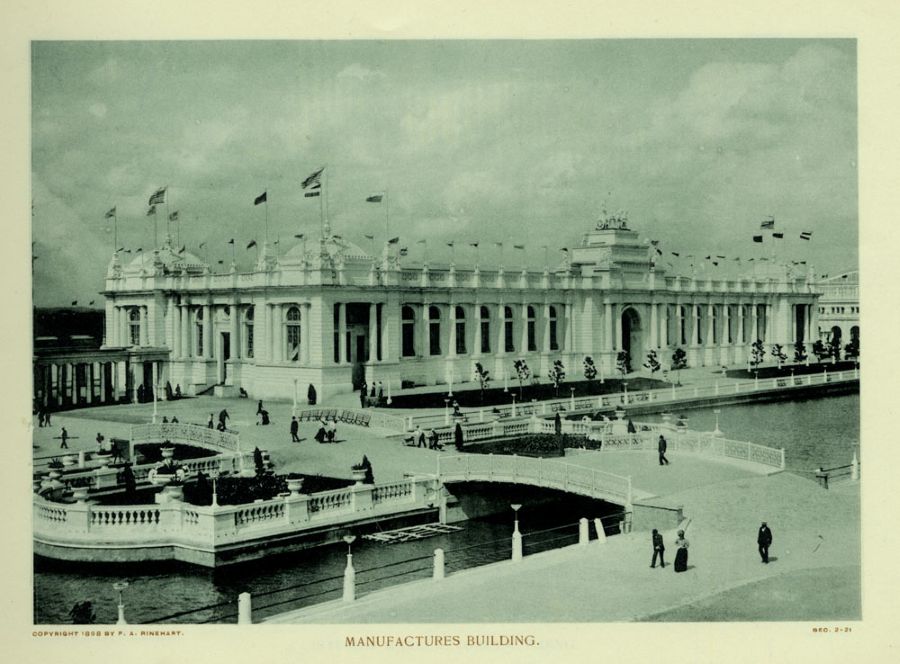
Photograph by Rinehart (Ibid.)
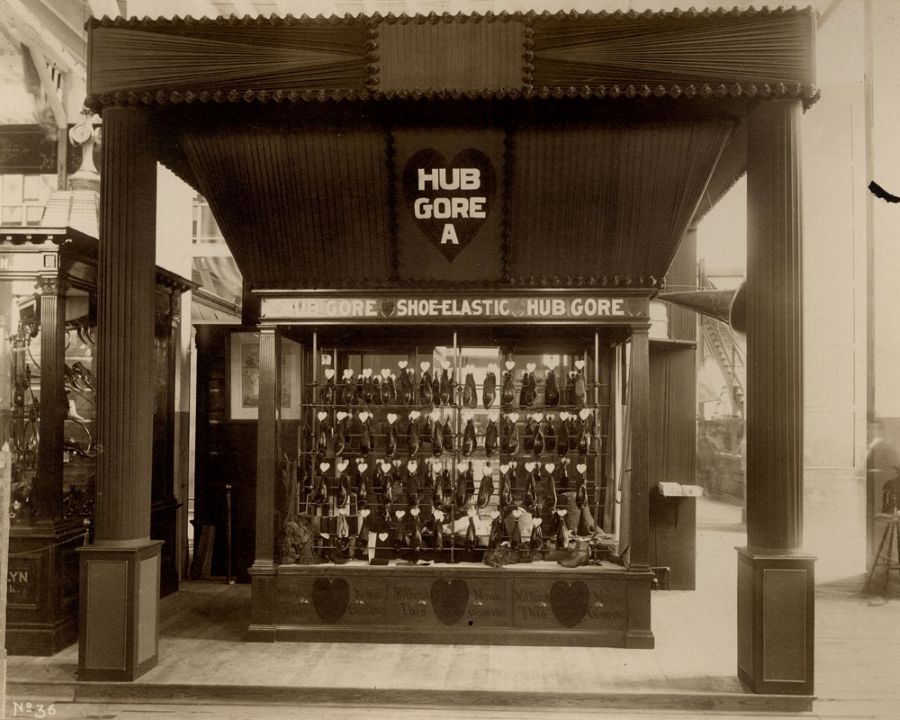
Hub Gore Shoe Display in Manufacturers Building. Note the Edison Concert Phonograph and its horn in the upper right of the display which may have been used for advertising Hub Gore Shoes with a recording of Uncle Sam promoting the shoes. Photograph by Rinehart.
See The World's Columbia Exhibition of 1893 for more details about the Phonograph advertising Hub Gore Shoes.
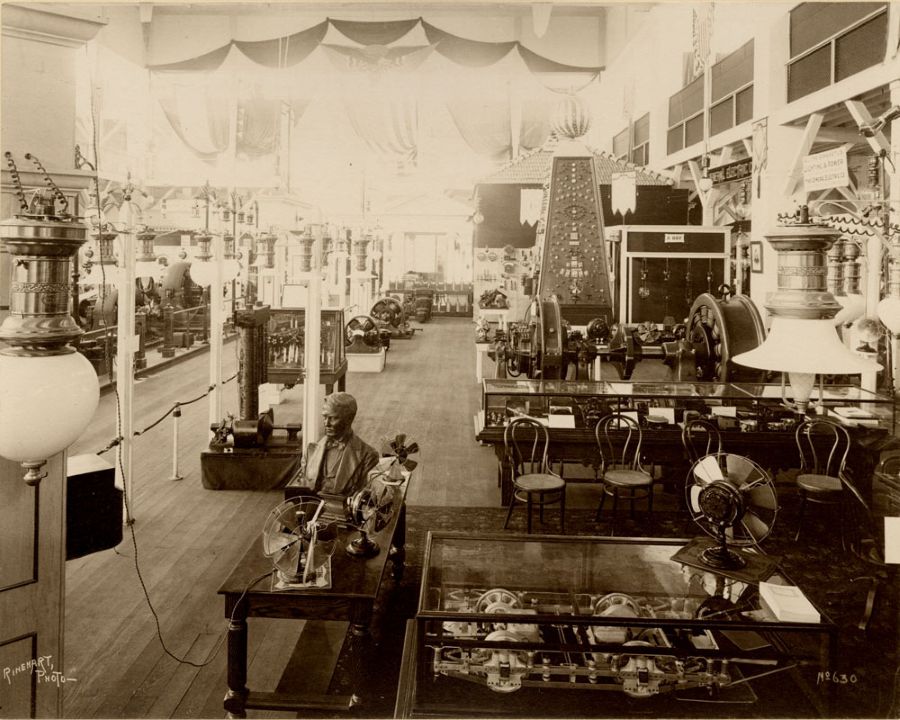
Edison bust, fans and motors inside Grand Court, North East Interior of Machinery & Electricty Building by F. A. Rinehart, Center for Digital Research in the Humanities UNL-Libraries.
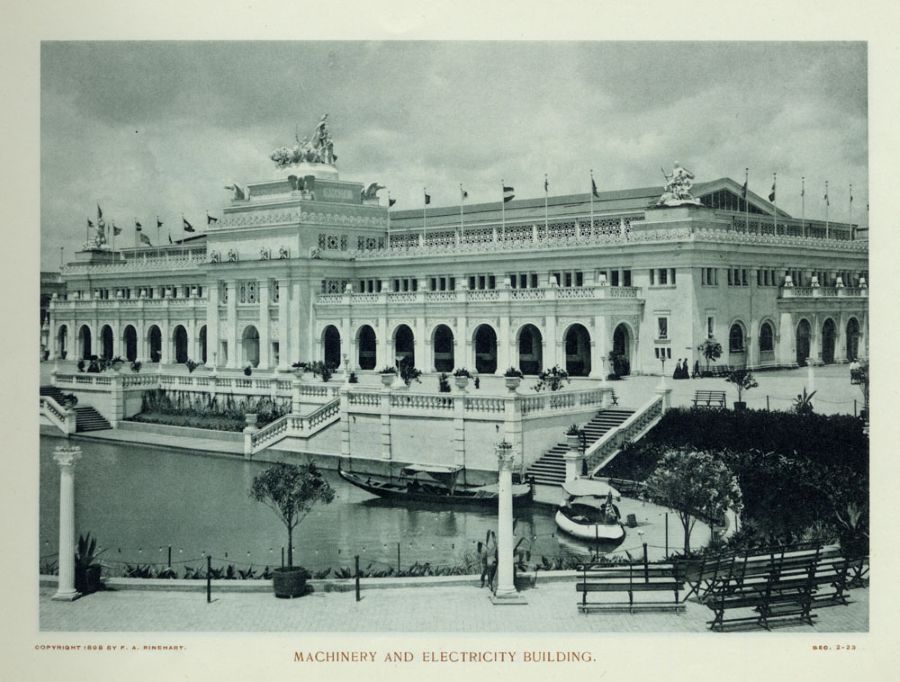
(Photograph by Rinehart, Ibid.)
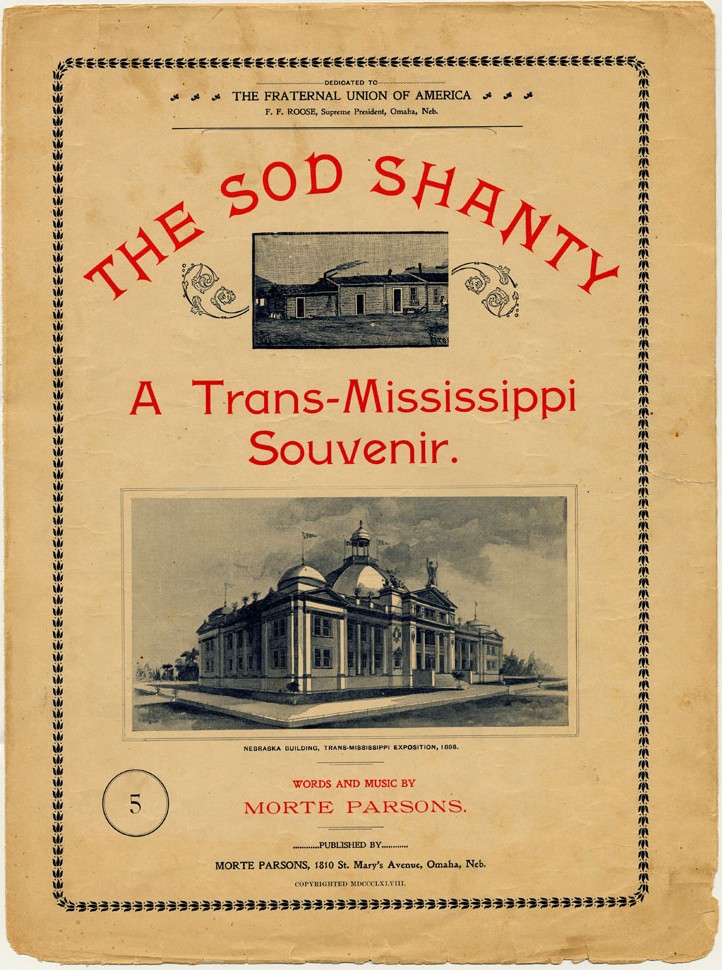
"The Little Sod Shanty on the Plains," a song written for the Trans-Mississippi and International Exposition. Sheet music cover includes images of a shanty and of the Nebraska State Building on Bluff Tract. (Ibid.)
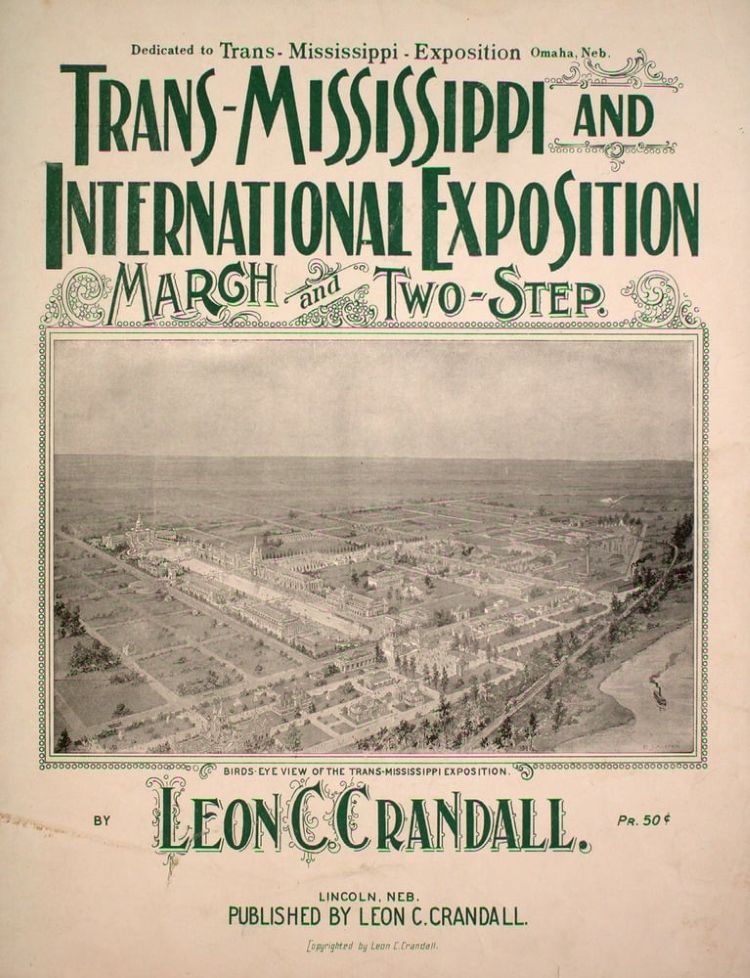
"The Trans-Mississipi and International Exposition March and Two Step." (Sheet music courtesy of Lester S. Levy Sheet Music Collection, Johns Hopkins, Sheridan Libraries.)
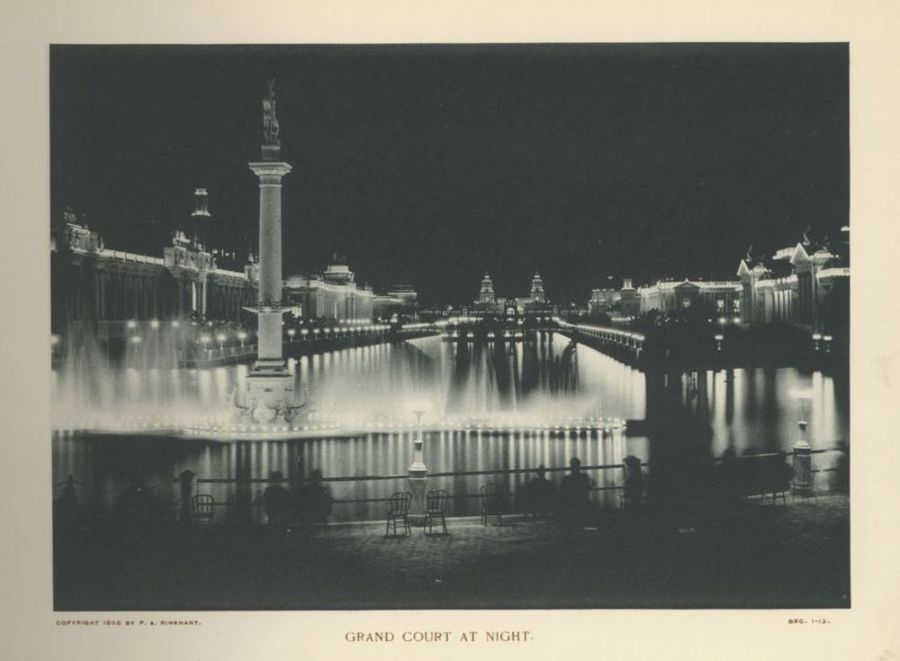
Grand Court at Night Photograph by Rinehart ("Rinehart's Book of Views") Center for Digital Research in the Humanities UNL-Libraries.
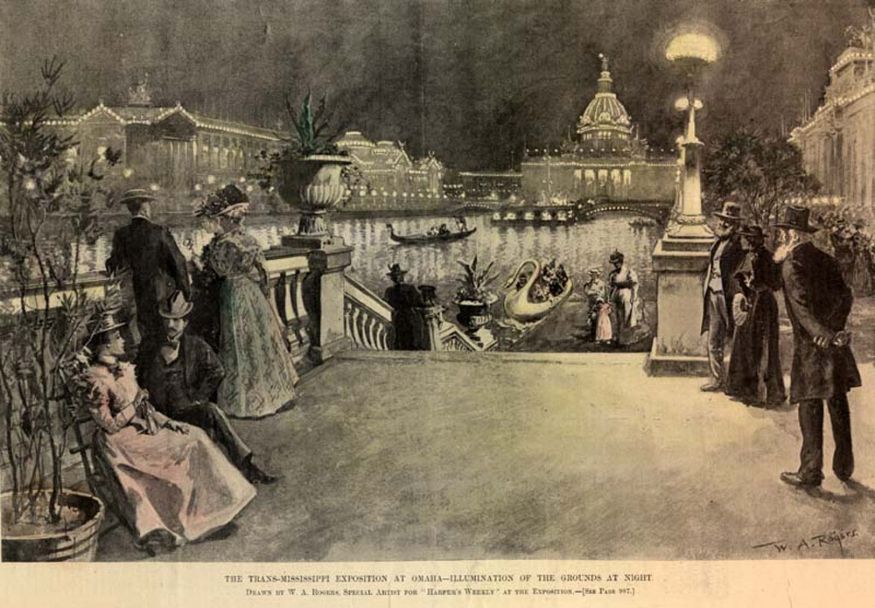
Harpers Weekly; Trans-Mississippi grounds. Grand Court at Night, looking west. Liberal and Fine Arts Buildings to the southwest. U.S. Government Building to the west, and Manufactures' building to the north. Light crowd at top of step leading to lagoon. Gondolas and swan boat in lagoon. Ibid.
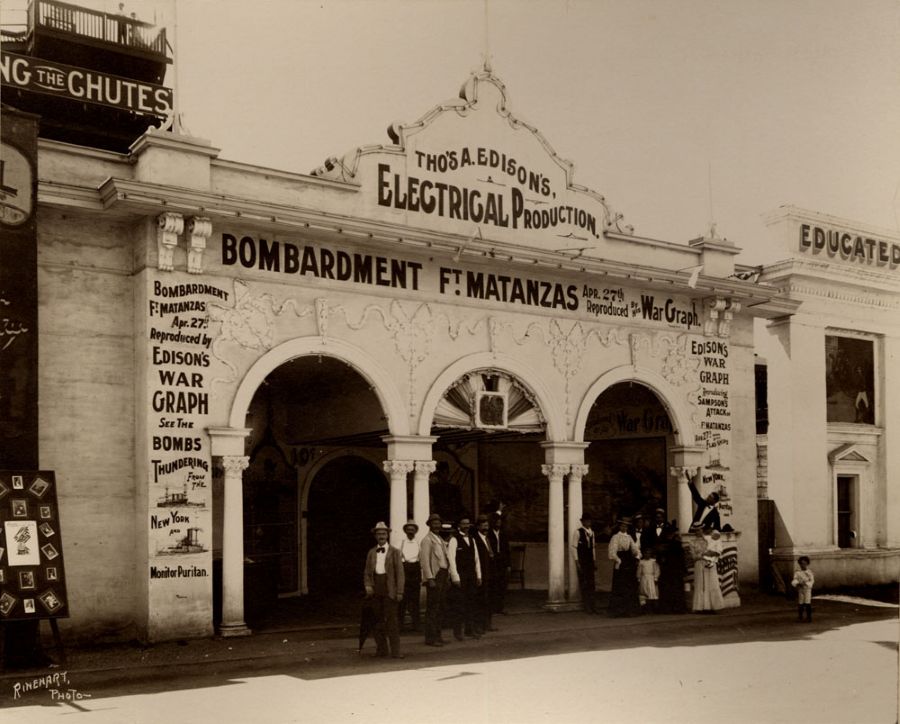
EDISON'S WARGRAPH THEATRE
On the Exposition's Midway was Thos. A Edison's Electrical Production attraction which showed action scenes created by what was coined "Edison's Wargraph" (moving pictures about the Spanish-American War using Edison's Vitascope). "See the thundering bombardment" delivered by the U.S. New York and Monitor Puritan Naval ships during the Spanish-American War read its entry walls. "Wargraph," however, may have been a way to avoid using the name of the company that did the actual filming, e.g., the American Vitagraph Company which was a competitor of Edisons, or American Mutoscope & Biograph Company.
One of Vitagraph's first claims to fame came from newsreels: Vitagraph cameramen were on the scene to film events from the Spanish–American War of 1898. These shorts were among the first works of motion-picture propaganda, and a few had studio re-enactments that were passed off as footage of actual events (The Battle of Santiago Bay was filmed in an improvised bathtub, with the "smoke of battle" provided by Mrs. Blackton's cigar). (J. Stuart Blackton was one of the co-founders of Vitagraph). (Wikipedia)
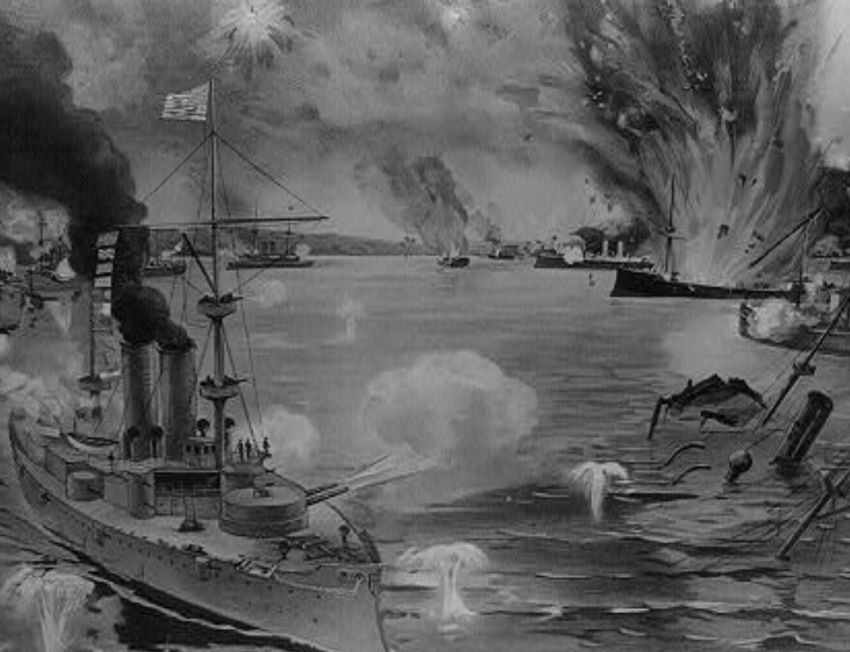
Print showing naval battle in Manila Bay, Philippines, between the Asiatic Squadron of the U.S. Navy under the command of Admiral George Dewey and the Spanish fleet on May 1st 1898. Muller, Luchsinger & Co., 1898 (Library of Congress)
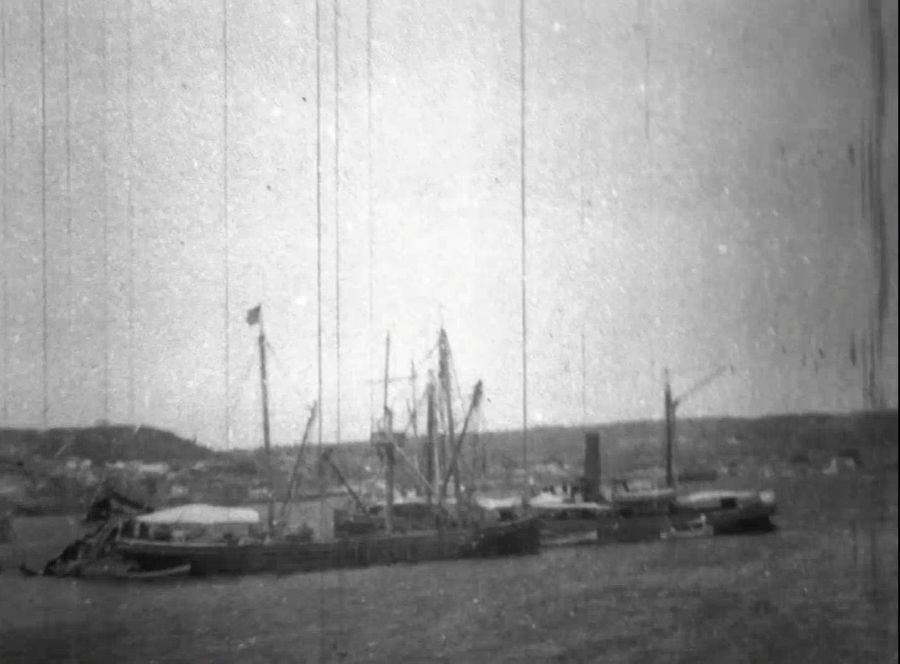
Screenshot from Edison moving picture of Wreck of the battleship "Maine" (WATCH) in Santiago harbor, Edison Manufacturing Co., Copyright April 21, 1898. Library of Congress.
The Library of Congress's Collection of movies features 68 motion pictures, produced between 1898 and 1901 and notes that )"The Spanish-American War was the first U.S. war in which the motion picture camera played a role. These films were made by the Edison Manufacturing Company and the American Mutoscope & Biograph Company and consist of actualities filmed in the U.S., Cuba, and the Philippines, showing troops, ships, notable figures, and parades, as well as reenactments of battles and other war-time events.
"The Omaha World-Herald," June 28, 1898 reported that "Manager Bayless of the Wargraph put on a new picture Thursday, and hundreds of people were delighted. The picture is an exact representation of the bombardment of Fort Matanzas, April 27. It reached here Thursday from the Edison Manufacturing company."
"The Omaha World-Herald," July 12, 1898 reported that Manager E. M. Bayless of the Edison wargraph is making decided improvements at his already very handsome front. His show is constantly growing in favor and every one who sees it is a walking advertisement. Many new pictures have been added recently and Mr. Bayless says he has more on the road. The picture reproducing the bombardment of Fort Matanzas has created a genuine sensation.
WOULD BE A GREAT LIFT - "The Omaha World-Herald," August 5, 1898.
Bayliss, Edison's Wargraph: "My reasons for lowering the 25 cent rate is that on the two nights which this rate has been made, my receipts have been more than doubled. Average has been tried in other such expositions and has been the means of bringing financial success to the exposition, and midway shows. I am sure four fifths of the shows will go from the Omaha exposition losers on their investment unless this rate is given. And, again, the Omaha working people coming at 7 p. m., cannot see one-third of the exposition, and it is no more than equity they should pay 25 cents. The visitor to the city would not wait until night to save 25 cents where his hotel bill is from $3.00 to $4.00 per day. Hence I beg the support of your good paper in obtaining the 25-cent night rate."
CHEERS FOR EVERYBODY - "The Omaha World Herald," September 18, 1898.
Then the generosity of Mr. Hibbard paired off with the liberality of the management of the Edison wargraph, and the 300 little folk were taken in to see the bombardment of Fort Matanzas and other pictures. The marching troops were cheered, the bull fighters were cheered, the Maine was cheered, the Vesuvius was cheered—in fact, everything was cheered—and the little folk were delighted with the splendid exhibition.
GLIMPSES OF THE MIDWAY. - "The Omaha-World Herald," October 13, 1898.
Concessions Crowded With the Mass of Visitors. E. M. Bayliss of the Edison Wargraph refused to sell tickets yesterday on a dozen or more occasions, but not because he wanted to. All day long the building, the lobby and the Midway in front of the show were thronged with people anxious to see the battle of Manila and the bombardment of Fort Matanzas.
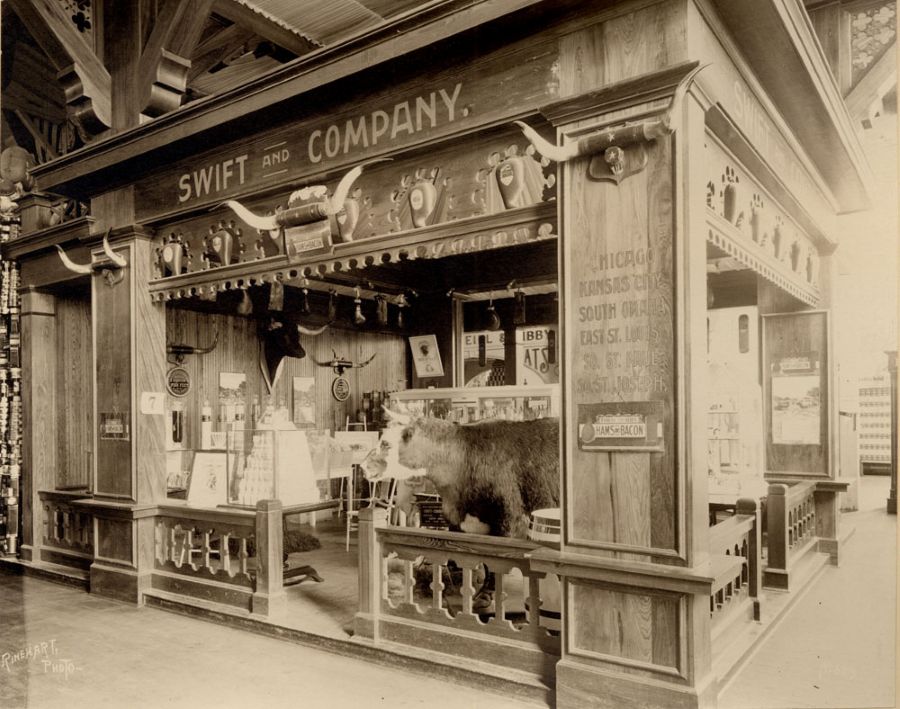
Interior of Manufactures Building. Swift and Company Hams and Bacon display by F. A. Rinehart, Center for Digital Research in the Humanities UNL-Libraries.
The Swift Exhibit's Phonographic Reproduction of Pig Squeals, "The Omaha World-Herald," Sunday, July 24, 1898.
The phonographic reproduction of the squeals in the hog killing establishment at South Omaha is one of the interesting features at the Swift exhibit in the Manufactures building. A lady visitor from out of town stopped there yesterday to listen to it and inquired of the attendant, "Where is that from?" "South Omaha," was the reply. The lady looked at him doubtingly before remarking, "It sounds very much like the way they squeal at the packing houses at Kansas City. Are you sure there isn't any mistake?" The attendant assured her that there was no mistake, and that hogs actually squealed at South Omaha in the same language as that employed at the mouth of the Kaw. (Note: "Kaw" is the Kansas River.)
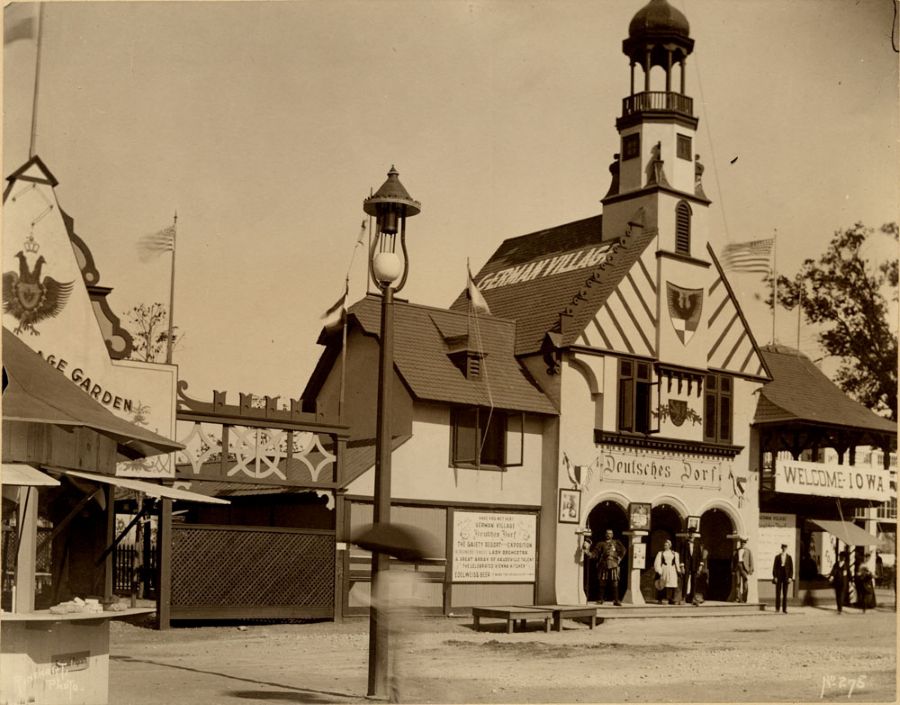
The German Village (catering to those who attend the concerts) was located in the Midway and was known for its "Continuous Vaudeville, The Celebrated Vienna Kitchen, Edelweiss Beer, and Kirschner's Famous Lady Orchestra."
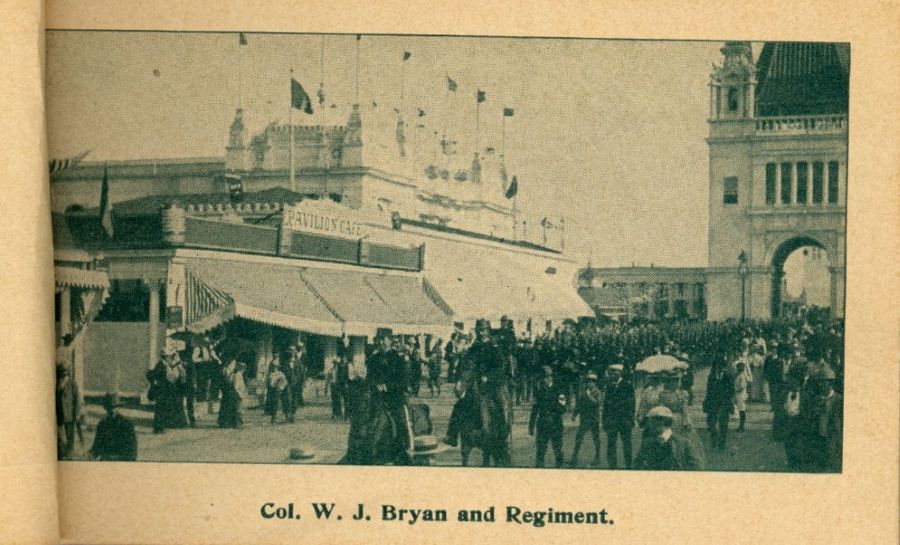
Col. William Jennings Bryan and Regiment parading down the Midway. (Ibid.)
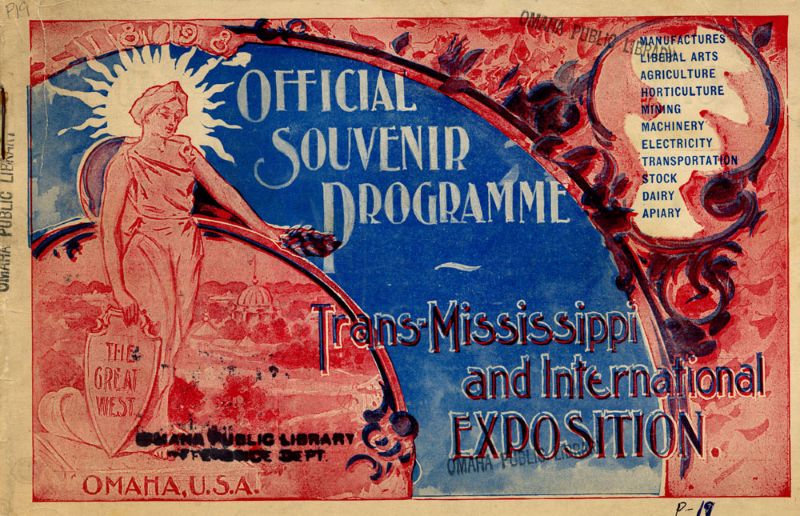
In the Official Souvenir Programme, Edison's Vitascope showing moving pictures is identified as being located in the North Midway of the Exposition grounds. (Ibid., UNL-Libraries).
Live instrumental music was performed daily by such bands as Phinney's United States Band, Pawnee City Bands, the Thomas Orchestra, the United States Marine band, along with a host of vocal and other musical performances. As A. Melver-Brisbine wrote in an article titled "Music at the Exposition," in the "Omaha Daily Bee," June 1, 1898, "Five Months of Vocal and Instrumental Harmony (are) in Store."
"TWO VERY ENJOYABLE CONCERTS"
The June 6, 1898 "Omaha Daily Bee" reported "TWO VERY ENJOYABLE CONCERTS" Marine Band Delights the People with Its Excellent Performances.
The Marine band gave two concerts yesterday and in each case their musicianly work commanded the enthusiastic approbation of very creditably audiences. The afternoon program was rendered in front of the Government building at 2:30 o'clock and its character was admirably adapted to the people and who constituted the bulk of the audience.
The evening concert on the Grand Plaza included some of the most enjoyable compositions that have yet been heard at the exposition. It was introduced with the grand march from "Rienzi" and included the "Grand Jubilee" overture, which was composed by Mr. Santelmann expressly in honor of the Transmississippi Exposition. A very pretty number and one seldom imitated in band concerts consisted of an arabesque and the slumber song by Schumann. These were exquisitely rendered and the cornet solo by Walter F. Smith was also warmly received. The program ended with the "Star Spangled Banner."
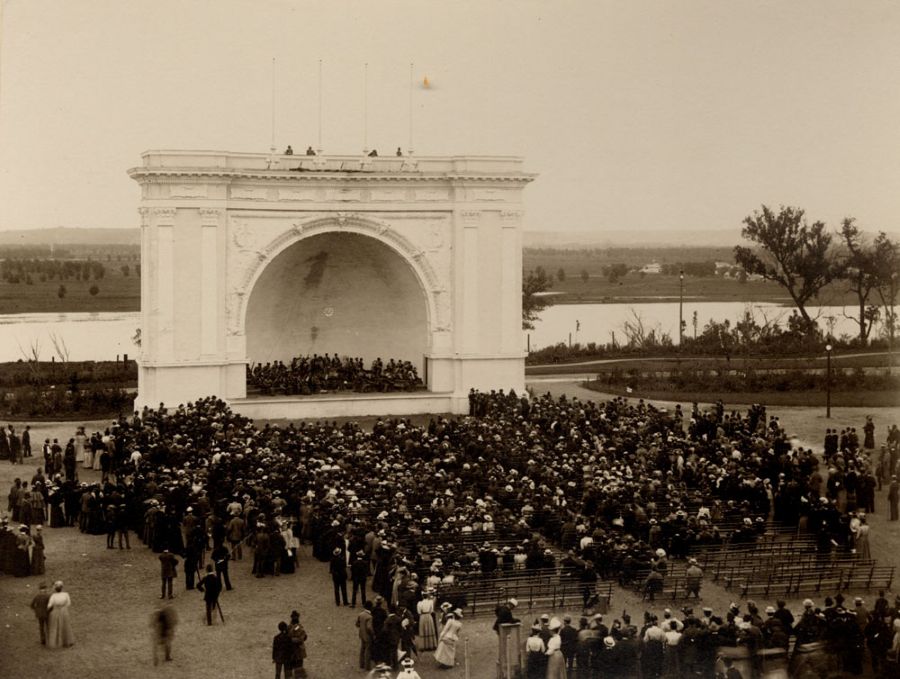
Band Stand on Grand Plaza looking east, (Rinehart, Ibid., UNL-Libraries).
Coin-Operated Machines
Regulations and licensing for coin in the slot machines (including those "furnishing Music") was approved on May 10, 1898 in Omaha, Nebraska (just before the opening of the Trans-Mississippi Exposition). This ordinance would not have impacted phonograph parlors or coin-operated phonographs inside businesses as it was directed at devices on streets, alley's and sidewalk's of Omaha.
Section I. It is hereby declared unlawful for any person, persons, corporations, company or association to place, exhibit or operate, or authorize to be placed, exhibited or operated on any streets, alley or sidewalk of the city of Omaha any slot machine or other like contrivance or device in which may be deposited pennies or other coin for the delivery of merchandise, soft drinks, or for weighing, furnishing music, or which may be used for other like purposes, without first complying with the provisions of this ordinance, and obtaining a license, as herein required.
"The sum of five ($5.00) dollars for each slot machine, or other like device or contrivance proposed to be used for the purposes herein contemplated." "Penalties for not complying with the conditions of this ordinance and obtaining a license, as herein provided, shall be deemed guilty of a misdemeanor, and upon conviction thereof shall be fined in any sum not exceeding $25.00 or be imprisoned not exceeding ten days, or may be both fined or imprisoned, as may be determined by the judgment of the court." (Reported by "The Phonoscope," July 1898)
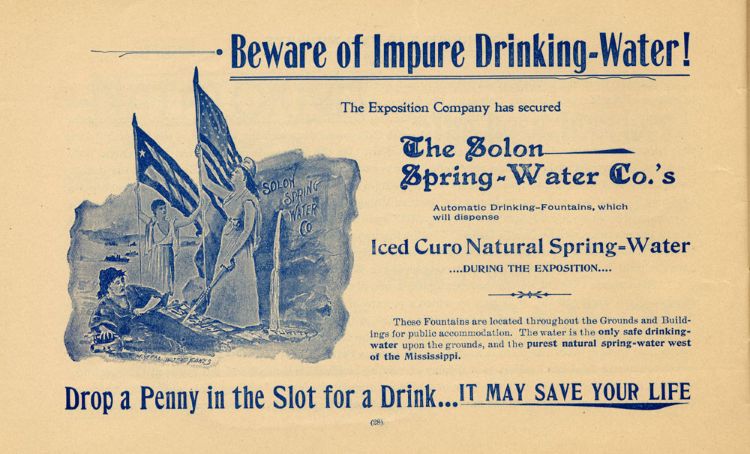
Salon Spring Water Automatic Drinking Fountains. "Drop a Penny in the Slot for a Drink. It May Save Your Life." - (Ibid).
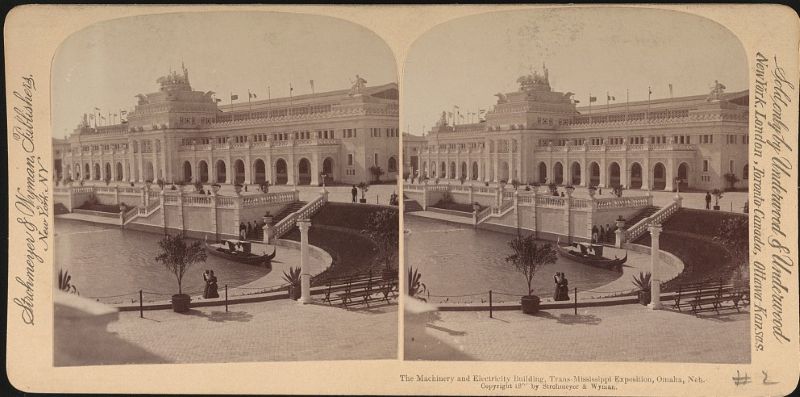
Stereoview card of Machinery and Electricity Building. (Library of Congress)
See 1898 Trans-Mississippi & International Exposition for additional photographs, memorabilia and texts.
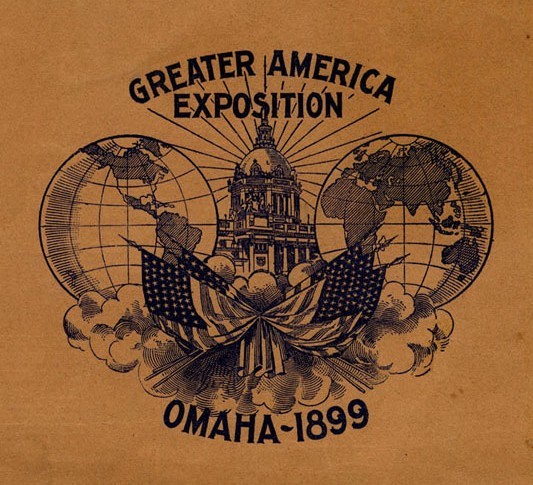
THE GREATER AMERICA EXPOSITION of 1899
In August 1898, the Spanish-American war ended, and in late November, Spain accepted the American terms for peace. In December, President McKinley said he favored Omaha hosting another expo during 1899 for the nation to share its new “possessions” gained from the war. That included Cuba, Guam, Philippines, and Puerto Rico.(Adam Fletcher Sasse, October 9, 2015 "A History of the 1899 Greater America Exposition in North Omaha").
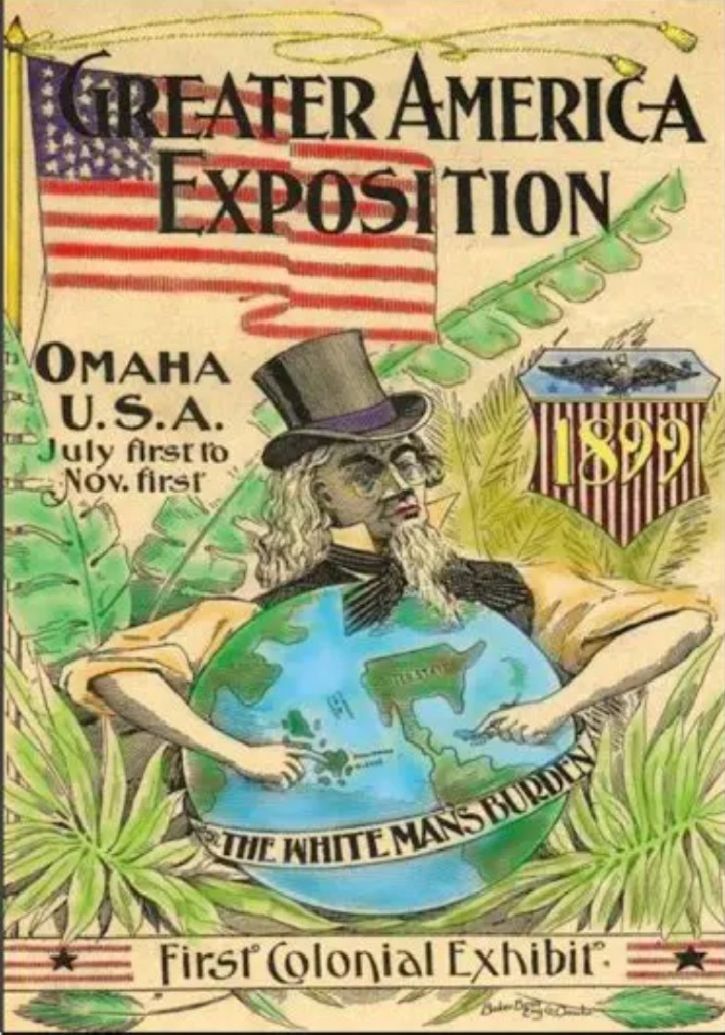
This exposition, however, was not a success, and its themes of colonialism and American
were "intended to be a celebration of American colonialism, the American empire, and the spread of military-driven capitalism. Many of the presentations were plainly racist, actively and deliberating attempting to show that white people were superior to every other person around the world." (ibid.)
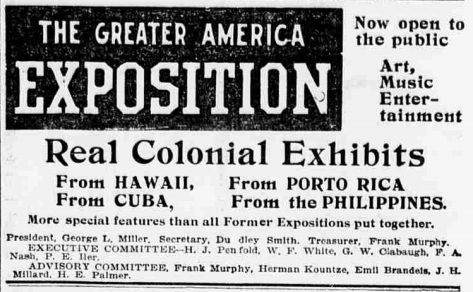
Greater America Exposition Ad, 1899.
The Greater American Exposition had opened on May 8, 1899 and in early July it was out of operating funds. A new manager secured funds to continue operating but that same week the "Denver Times" wrote their opinion of what this exposition really was, reporting that the Greater American Exposition had no government exhibits, no exhibits from neighboring states, no mining exhibit, no agriculture exhibit, and nothing else of substance. Instead, they declared “it is an Omaha Scheme, simply a big carnival midway.”
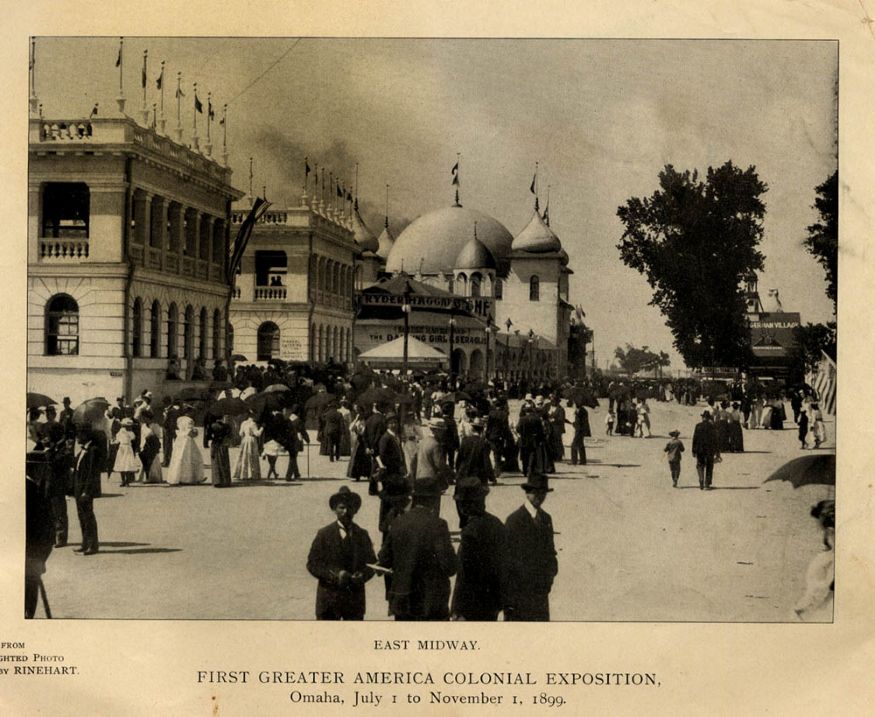
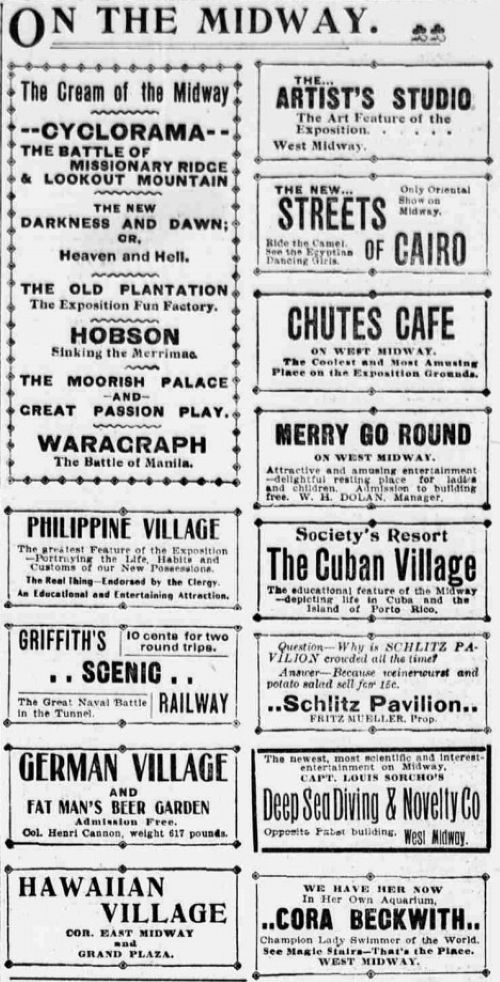
"On the Midway" ad for Greater American Exposition, "The Omaha Daily Bee," June 1899. (North Omaha History by Adam Fletcher Sasse)
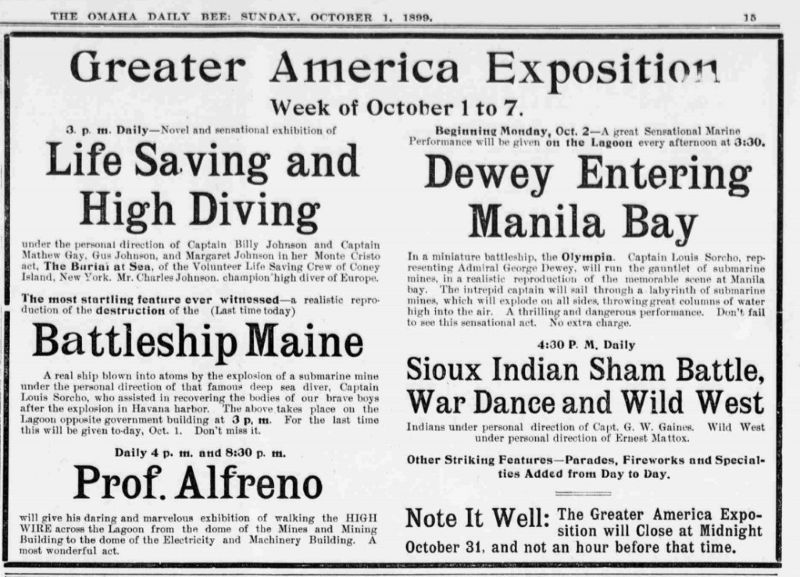
Ad for Greater American Exposition, "The Omaha Daily Bee," October 1, 1899. (ibid.)
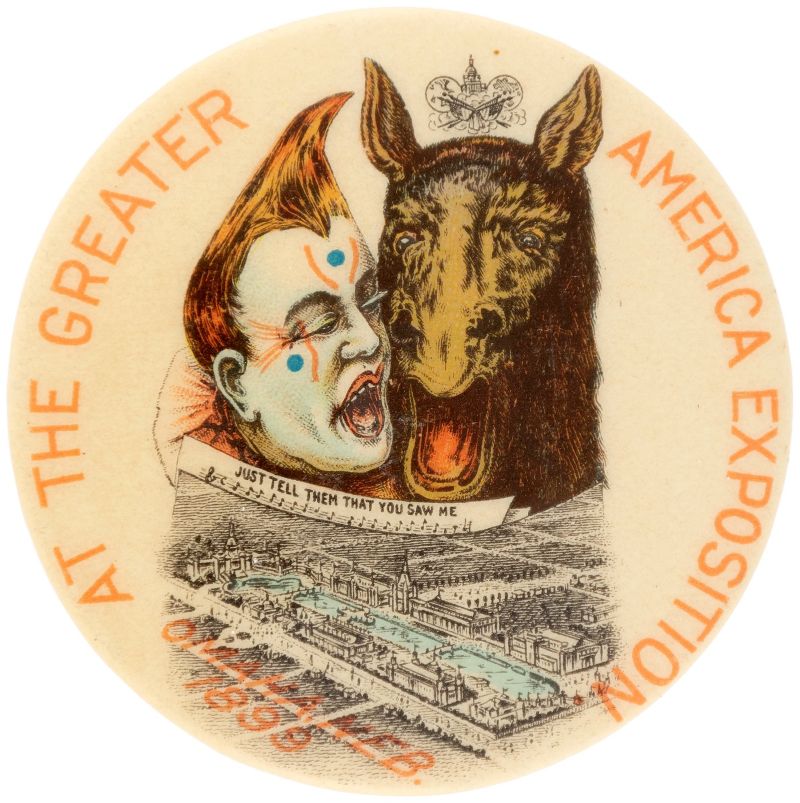
AT THE GREATER AMERICA EXPOSITION BUTTON, 1899. (Hake's Auctions)
EDISON'S WARGRAPH THEATRE
The Greater America Exposition's midway was popular and Edison's "Wargraph" continued its Spanish-American war themes to match the events of the day. One presentation was the sinking of the United States Navy's Merrimac, the only US ship that the Spanish Navy sank in that war. Such a film, however, has not been found and it likely a re-enactment that were passed off as footage of the actual event like advertised "Battle of Manila" Wargraph presentation.
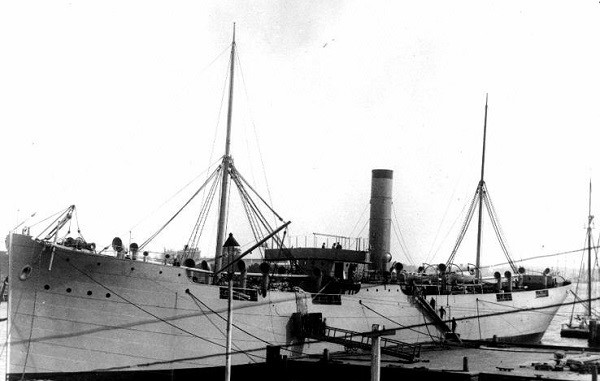
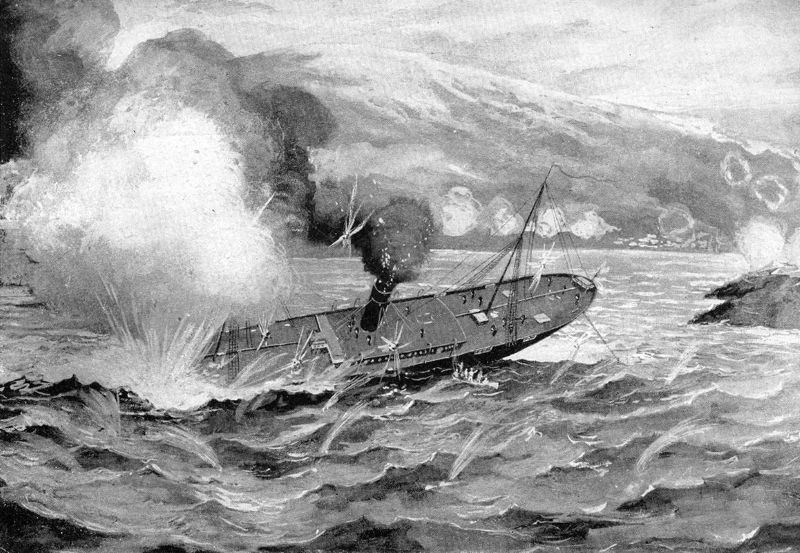
Print of S.S. Merrimac sinking June 3, 1898 (latinamericanstudies.org).
For more details, see "The Sinking of U.S. Navy Collier Merrimac" by Patrick McSherry.